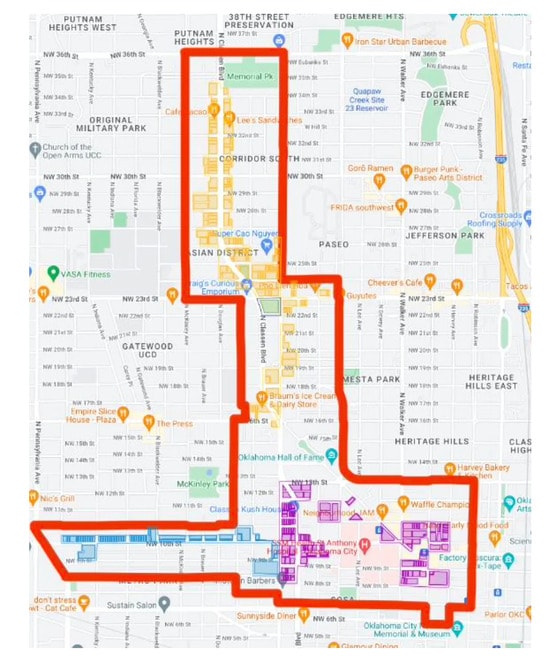Last Updated on April 17, 2024, 9:11 PM | Published: April 17, 2024
OKLAHOMA CITY — Councilors James Cooper and JoBeth Hamon hosted a public meeting April 16 to educate the community about a potential TIF district for Classen Corridor, which impacts Wards 2 and 6, represented by Cooper and Hamon respectively.
Business owners, residents, and community organizers gathered in the Sarkeys Science and Math Building at Oklahoma City University to discuss the potential creation of a new Tax Increment Financing (TIF) district aimed at revitalizing the North Classen corridor.

About the proposal
In March, the Oklahoma City Council initiated the revitalization of NW Classen by forming a committee to evaluate a proposed new TIF district.
Mayor David Holt chairs the committee, assessing the proposed district’s financial impact for council approval, involving key stakeholders such as OKCPS, Metro Tech, the OKC Health Department, the Metropolitan Library System, and Oklahoma County Government.
The proposed TIF district aims to revitalize a corridor from Pennsylvania Avenue to Robinson Avenue, covering Downtown and nearby neighborhoods like Midtown and Mesta Park.
Cooper, Hamon guide community input on Classen Corridor revitalization
Representatives from the Asian District Cultural District Association, which is a part of the Classen Corridor, proposed utilizing a TIF for development in their district.
After the meeting, Cooper and Hamon talked to Free Press about the issues.
Cooper agreed with the sentiment, advocating for initiatives like streetscape enhancements, stressing the revitalization of Classen Boulevard to showcase the area’s Vietnamese heritage and foster a lively, pedestrian-friendly atmosphere with art, green spaces, culturally appropriate housing, and small businesses.
“I look forward to working with them to make Classen a boulevard for people again,” Cooper said.

Initially skeptical of TIFs due to concerns about disrupting existing development and gentrification, Hamon’s outlook shifted after discussions with groups like the Asian District Cultural Association. She now views the revitalization plan as a potential tool for community support due to conversations highlighting the importance of community engagement in addressing affordability and displacement issues.
Hamon praised the Asian District’s collaborative efforts with neighborhood groups to advance revitalization projects.
“I really do want to thank the Asian Cultural District Association for being a partner in this process and a great example of how they’ve worked so hard to build up a lot of sweat equity, people power, and volunteer hours,” Hamon said. “And I’m hopeful that we can help build this proposal to Council as something to continue that work to continue that revitalization.”
Both Cooper and Hamon expressed the desire to hear directly from residents before proceeding further and emphasized the importance of input, not just from property owners, but also from residents, workers, students, and those who have contributed to the community in the area.
“This is something that I was really committed to making sure we did as part of this process,” Hamon said. “Because often I feel like things that governments do feel like they’re being done to people rather than with people and with communities.”
Community engagement in action
The community meeting aimed to gather input from residents on TIF districts and improvements along Classen Boulevard.
Cooper and Hamon encouraged diverse participation, urging attendees to “dream big” and share their ideas for the future. Suggestions included an Asian District gallery and improvements in traffic safety and affordable housing. The meeting provided a platform for residents to voice their opinions and ask questions, and it drew a diverse audience, including OCU students and business owners.
The session kicked off with Hamon and Cooper providing an overview of TIFs, followed by presentations from Joanna McSpadden and Geoff Butler, with the City of Oklahoma City.
TIF 101
McSpadden, heading the city’s economic development, offered an in-depth explanation of TIFs, explaining how they use property taxes from specific areas to drive local growth. Rising property values channel surplus funds into development projects or private investment, enhancing infrastructure, schools, and local programs.

Typically spanning 25 years, TIFs initially freeze property value assessments to maintain existing tax revenues. McSpadden detailed a $70 million budget spanning 25 years for a project, where funds grow alongside property value from new developments, with a notable portion earmarked for incentivizing further development, pending approval.
McSpadden underscored the importance of community involvement in TIF-related processes, advocating for responsible development initiatives through comprehensive project evaluation.
Butler, as a city planner, explained zoning decisions on the map, focusing on revenue-generating properties like Midtown, aiming to enhance public transportation and improve the neighborhood for increased property taxes. Crafting successful TIF districts involves strategic property selection based on revenue potential and risk avoidance.
“If you want to have a successful TIF district, you need to generate revenue,” Butler said.

Residents’ concerns
Some attendees expressed concerns about the proposed TIF’s impact on affordable housing and gentrification. Community leaders emphasized the need to maintain urban affordability, considering transportation accessibility and the needs of non-car owners.

Butler, the OKC city planner, pledged close monitoring of gentrification and proposed plans for subsidized housing and increased affordability funding.
Some concerns about affordable housing arose from the impact of the Wheeler District’s TIF, which has had a mixed reception surrounding its effectiveness.
Hamon highlighted an absence of affordable housing requirements in the Wheeler TIF and urged for inclusion in future developments, making it a priority for the Classen TIF. She proposed integrating these requirements into project plan documents to ensure developers commit to building inclusive communities.
Hamon outlined the next steps for TIF districts, involving refining property descriptions and project plans to establish goals, legal frameworks, and requirements for developers seeking funds. She also advocated for mandating mixed-income housing and a balanced approach where developers contribute to the community, emphasizing the need for housing subsidies prioritizing working people and communities.
Both Hamon and Cooper supported a fairer housing policy meeting the needs of everyday working people.
Residents in the meeting raised concerns about enhancing community livability through questions about mixed-use commercial and residential spaces, traffic safety, and walkability.
Attendees Chelsea Banks (feature photo) and Jenny Nguyen, both familiar with these issues, emphasized their importance in community improvement.

Banks, a community leader, helped organize the inaugural Uptown Outside event in 2022, while Nguyen, president of the Asian District Cultural Association, has experience with the Asian Night Market Festival. Both stressed the significance of walkability based on their outdoor event-organizing experiences, believing it to be attainable for the area.
“I think we really have an opportunity if this continues to go the path of tonight,” Banks said. “It has opened the door for an opportunity for the community to define the growth trajectory of Oklahoma City in the future. And that looks very walkable and very easy to get to basic needs without a car or any other vehicle.”
Banks commended the collaboration of the community meeting, emphasizing diverse perspectives and direct involvement in shaping Oklahoma City’s growth as well as inclusive decision-making to prevent gentrification and ensure communal investment in the city’s future.

Jenny Nguyen, president of the Asian District Cultural Association and business owner, emphasized the need for infrastructure upgrades such as crosswalks and park amenities, citing challenges in accessing green spaces for events and proposing enhancements to Military Park.
Nguyen was also involved in pitching the revitalization plans to Cooper and Hamon and highlighted a partnership between City Council and the Asian District, noting progress and growing community interest.
She highlighted the potential of events like the Asian District Night Market to bring to light the importance of walkability and safety in neighborhood development, speaking from her perspective as both a business owner and resident.
“We’re no longer just like this little strip of land or strip of Oklahoma City where we just see business,” Nguyen said. “People live their life here.”
Hamon and Cooper reflect on meeting outcomes
Cooper and Hamon praised the community meeting’s success in engaging residents, gathering input, and sparking constructive discussions for inclusive city development.
“It feels like we were able to capture people that aren’t maybe always in the room, and help them understand a little bit more about what this means and how those tools are used, and just give them a better grasp of what this might mean for them,” Hamon said.

Hamon and Cooper emphasized the importance of addressing rising living costs and focused on housing development, affordability, and urban access, advocating for ongoing discussions and actions to prevent displacement and support community-based initiatives.
“There was such a stated need here tonight for affordable housing to be a component, which of course, Councilwoman Hamon and I are already championing, and to deal with the fact that, for too long, the city government has allowed the Classen Corridor to become a commuter district.”
Hamon and Cooper expressed optimism, seeing improved livability through affordable housing, walkability, and transit-oriented development, especially along the BRT line within the proposed TIF boundaries, highlighting the benefits of successful development for a sustainable, accessible urban environment, particularly in areas like Classen Corridor and left feeling positive about the meeting’s outcome.
“I felt like people asked good, strong questions,” Cooper said. “And so now it’s going to be up to staff and Councilwoman Hamon and I to turn that into a narrative of what we’d like to see over the next few years on Classen.”
Zoe Travers has spent her career covering local musicians, artists, politicians, and everyday folks. She is also Oklahoma City’s most enthusiastic connoisseur of cheese danishes.











